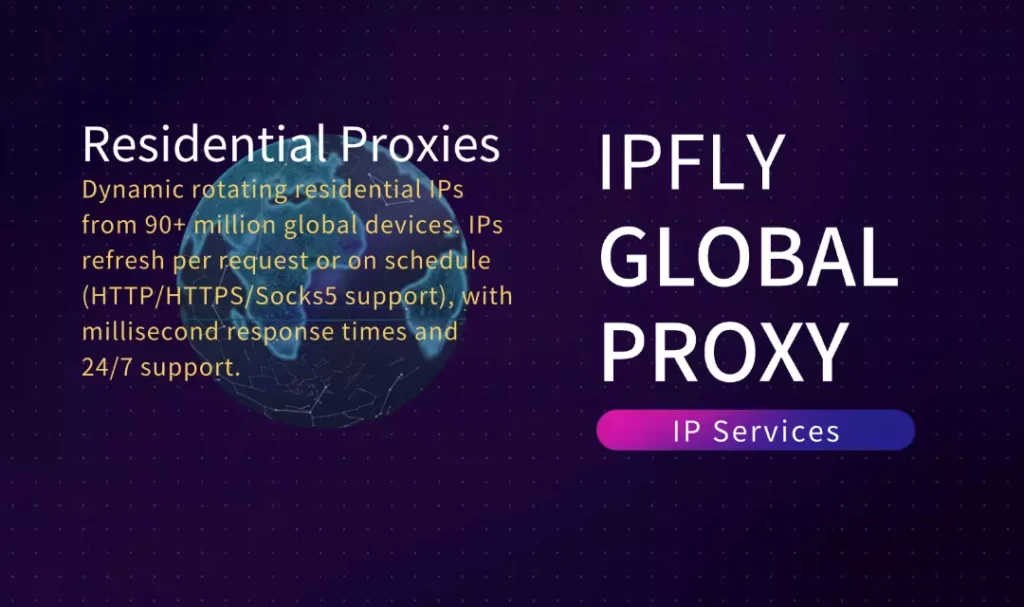Residential proxy IPs represent a sophisticated tool in the arsenal of digital networking, functioning as intermediary addresses sourced from genuine household internet connections to facilitate secure and anonymous online interactions. Imagine these proxies as chameleons in the natural world, blending seamlessly into their surroundings by adopting the characteristics of everyday environments to avoid detection. In technical terms, a residential proxy IP is an IP address assigned by an Internet Service Provider (ISP) to a real residential user, which is then utilized by proxy services to route your traffic. This creates the illusion that your requests originate from an ordinary home network, rather than a commercial or automated source, thereby evading the scrutiny of websites’ anti-bot systems that rely on pattern recognition algorithms to identify suspicious activity.
From a scientific perspective, residential proxy IPs draw upon principles of behavioral mimicry and network topology. Just as animals in ecology evolve traits to imitate their habitat for survival, these proxies replicate the organic traffic patterns of residential connections—variable usage times, geographic consistency, and human-like browsing behaviors—to reduce the entropy that might flag automated processes. This makes them particularly effective for tasks where authenticity is key, as websites often prioritize or whitelist residential IPs to distinguish legitimate users from scripts or crawlers. The underlying technology involves packet encapsulation, where your original data is wrapped in a new header bearing the residential IP, allowing it to traverse the internet undetected while preserving the integrity of the payload. This article, styled as a popular science tutorial, delves into the mechanics, benefits, applications, and practical setups of residential proxy IPs, offering analogies from nature and step-by-step guidance to help you grasp and apply this concept effectively.

The Core Principles of Residential Proxy IPs and Their Network Role
To fully appreciate residential proxy IPs, consider the foundational structure of internet addressing. Every device connected to the web is identified by an IP address—a unique numerical label that routes data packets across the global network, similar to how coordinates pinpoint locations in a vast geographical map. Residential proxy IPs are sourced from real ISP-assigned addresses tied to physical homes, distinguishing them from datacenter proxies, which originate from server farms and are more easily detected due to their uniform patterns.
Scientifically, the advantage lies in mimicry of human behavior: residential IPs exhibit natural variations in activity, such as peak evening usage or regional clustering, which align with statistical models used by websites for traffic analysis. This reduces the probability of blocks, as anti-fraud systems employ machine learning to flag outliers—residential proxies lower the anomaly score by blending into the baseline. The proxy server acts as a relay: it receives your request, substitutes the source IP with a residential one, forwards it to the target, and relays the response back, all while maintaining encryption to protect against interception. This encapsulation process is akin to cellular transport in biology, where molecules are packaged and shuttled across membranes without altering their core structure. By drawing from large pools of consented residential IPs, these proxies ensure diversity, rotating addresses to distribute load and further evade detection algorithms that track repetitive patterns.
How Residential Proxy IPs Work: A Step-by-Step Mechanism
The functionality of a residential proxy IP can be broken down into a clear sequence, much like dissecting a biological process in a lab to observe each stage of cellular division. This tutorial-style explanation allows you to visualize the flow as if conducting an experiment in network simulation.
1.Request Initiation: Your device generates a web request (e.g., to load a page or fetch data), but instead of sending it directly, client software routes it to the proxy server over a secure connection, such as HTTPS or SOCKS5, to prevent eavesdropping.
2.IP Selection and Substitution: The proxy selects a residential IP from its pool—often based on criteria like location or availability—and rewrites the packet header, replacing your original IP with the residential one. This step leverages network address translation (NAT), a fundamental technique in routing where addresses are mapped without changing the data content.
3.Forwarding to the Target: The modified packet is sent to the destination website, which processes it as if coming from a standard home user, thanks to the authentic ISP origin that aligns with expected traffic norms.
4.Response Handling: The site replies to the proxy’s residential IP; the proxy then strips any unnecessary metadata, re-encapsulates the response, and sends it back to your device, completing the round trip with minimal delay.
5.Rotation and Monitoring: For ongoing sessions, the proxy may rotate IPs to mimic natural variability, while logging metrics like latency (measured in milliseconds) to optimize performance, drawing from feedback loops in control theory.
This mechanism not only conceals your identity but also enhances reliability, with residential proxies achieving higher success rates in restricted environments compared to other types, as evidenced by network performance benchmarks.
Benefits of Residential Proxy IPs: Boosting Authenticity and Versatility
Residential proxy IPs provide a host of advantages, rooted in their ability to simulate real-user behavior. Chief among them is superior evasion of detection: websites use sophisticated heuristics to block non-residential traffic, but these proxies’ organic patterns—such as intermittent activity and ISP diversity—lower false positives, making them ideal for sustained operations. This aligns with probabilistic modeling in statistics, where blending into the “normal” distribution reduces outlier flags.
Performance benefits include stable connections with low latency, as residential networks often feature high-speed broadband, optimizing for bandwidth-intensive tasks. They also offer precise geo-targeting, allowing users to select IPs from specific regions for localized access, similar to how ecologists study species in native habitats for accurate observations. Security is bolstered through encryption support, protecting against man-in-the-middle attacks where data could be intercepted and altered. While costs may be higher due to the premium on real IPs, the trade-off is worthwhile for applications requiring long-term reliability.
Practical Applications: From Privacy to Professional Data Tasks
Residential proxy IPs find broad utility across various fields, leveraging their authenticity for ethical and effective outcomes. In privacy enhancement, they shield personal data during browsing, bypassing geo-restrictions for global content access—a process that simulates local presence without physical relocation, useful for travelers or researchers needing region-specific insights.
In data science and market research, they enable web scraping by distributing requests across IPs to avoid rate limits, facilitating large-scale collection for analysis without triggering anti-bot measures. Businesses employ them for ad verification, ensuring campaigns display correctly across locations by mimicking diverse users, or for competitive intelligence, gathering public pricing data ethically. Services like IPFLY exemplify this by offering residential proxy IP solutions with features such as unlimited concurrency and geo-targeting, making them suitable for enterprise-level tasks like SEO monitoring or social media management. Other uses include secure remote access and testing, where consistent, real-world IPs ensure accurate simulations.
Need high-standard proxy strategies or stable enterprise-grade services? Visit IPFLY.net now for professional solutions, and join the IPFLY Telegram community—get industry insights and customized tips to fuel your business growth and seize opportunities!

Hands-On Tutorials: Configuring and Using Residential Proxy IPs
To make this accessible, here are practical tutorials presented as guided experiments, allowing you to observe how proxies alter network behavior in real time.
Tutorial 1: Basic Browser Setup for Casual Use For testing anonymity:
1.Obtain proxy credentials (IP, port, username/password) from a reliable source.
2.Install a browser extension designed for proxy management.
3.Input the details and enable the proxy.
4.Visit a diagnostic site to confirm the residential IP is active, noting changes in geolocation data as evidence of successful masking.
This simple setup demonstrates immediate effects, ideal for beginners exploring privacy.
Tutorial 2: Integrating with Scripting for Automated Tasks For data collection:
1.Set up a programming environment with request-handling libraries.
2.Configure the script to use the proxy, including authentication.
3.Execute a loop to fetch data from multiple pages, rotating if needed.
4.Parse and store results, measuring success rates to refine the approach.
Example pseudocode for illustration:
import requests proxies = { 'http': 'http://username:password@residential-ip:port', 'https': 'http://username:password@residential-ip:port' } response = requests.get('https://target-site.com', proxies=proxies) print(response.text)This tutorial highlights automation, valuable for research or monitoring.
Tutorial 3: Monitoring and Optimizing Proxy Performance For advanced fine-tuning:
1.Use network tools to track latency and uptime during sessions.
2.Experiment with rotation frequencies, logging block incidents.
3.Analyze data for patterns, adjusting geo-selection for better fit.
4.Iterate based on results, ensuring ethical compliance in all tests.
This method fosters a scientific approach, treating proxy use as an ongoing experiment.
Ethical Considerations in Residential Proxy IP Usage
While residential proxy IPs empower users, responsible application is paramount—focus on legal tasks like privacy protection or data research, avoiding activities that infringe on rights or terms of service. Promote transparency in IP sourcing, ensuring consent from residential providers to maintain ethical standards and a sustainable digital ecosystem.
In conclusion, residential proxy IPs offer a compelling fusion of network science and practical ingenuity, providing tools to navigate the online world with authenticity and security. Through these tutorials, individuals can explore their capabilities thoughtfully, unlocking new possibilities in digital interaction while appreciating the elegant science at play.


